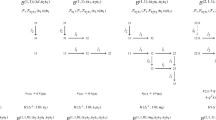Abstract
We present an effective algorithm for computing the standard cohomology spaces of finitely generated Lie (super) algebras over a field \({\mathbb{K}}\) of characteristic zero. In order to reach explicit representatives of some generators of the quotient space \({\fancyscript{Z}^ k /\fancyscript{B}^k}\) of cocycles \({\fancyscript{Z}^k}\) modulo coboundaries \({\fancyscript{B}^k}\) , we apply Gröbner bases techniques (in the appropriate linear setting) and take advantage of their strength. Moreover, when the considered Lie (super) algebras enjoy a grading — a case which often happens both in representation theory and in differential geometry—, all cohomology spaces \({\fancyscript{Z}^k /\fancyscript{B}^k}\) naturally split up as direct sums of smaller subspaces, and this enables us, for higher dimensional Lie (super) algebras, to improve the computer speed of calculations. Lastly, we implement our algorithm in the Maple software and evaluate its performances via some examples, most of which have several applications in the theory of Cartan-Tanaka connections.
Similar content being viewed by others
References
M. Aghasi, J. Merker, M. Sabzevari, Effective Cartan-Tanaka connections on strongly pseudoconvex hypersurfaces \({M^{3} \subset \mathbb{C}^{2}}\) . 113 pages, arxiv.org/abs/1104.1509
Aghasi M., Merker J., Sabzevari M.: Connections de Cartan-Tanaka effectives pour les hypersurfaces strictement pseudoconvexes \({M^{3} \subset \mathbb{C}^{2}}\) de classe \({\fancyscript{C}^{6}}\) . C. R. Acad. Sci. Paris, Sr. I 349, 845–848 (2011)
De Azcárraga J.A., Izquierdo J.M.: Lie Groups, Lie Algebras, Cohomology and some Applications in Physics, pp. 455. Cambridge University Press, Cambridge (1995)
Becker T., Weispfenning V.: Gröbner Bases, A computational approach to commutative algebra, pp. 574. Springer-Verlag, New York (1993)
Beloshapka V.K., Ezhov V., Schmalz G.: Canonical Cartan connection and holomorphic invariants on Engel CR manifolds. Russian J. Mathematical Physics 14(2), 121–133 (2007)
B. Buchberger, Ein algorithmus zum auffinden der basiselemente des restklassenringes nach einem nuildimensionalen polynomideal. PhD thesis, Universität Innsbruck, 1965.
Buchberger B.: An algorithm for finding the basis elements in the residue class ring modulo a zero dimensional polynomial ideal. J. of Symbolic Computation, Special Issue on Logic, Mathematics, and Computer Science: Interactions 41(3-4), 475–511 (2006)
A. Čap, J. Slovak, Parabolic Geometries I. Background and general theory. Mathematical Surveys and Monographs, 154, American Math. Society, 2009, x+628 pp.
D. Cox, J. Little, and D. O’Shea, Ideals, varieties, and algorithms. Undergraduate Texts in Mathematics, Springer-Verlag, New York, third edition, 2007, 536 pp.
Fuks D.B.: Cohomology of Infinite-Dimensional Lie Algebras, pp. 339. Plenum Publishing Corporation, New York (1986)
Goze M., Khakimdjanov Y.: Nilpotent Lie Algebras, pp. xvi+336. Mathematics and its Applications 361. Kluwer Academic Publishers Group, Dordrecht (1996)
P. Grozman, D. Leites, Mathematica aided study of Lie algebras and their cohomology. From supergravity to ballbearings and magnetic hydrodynamics, Proc. IMS’97.
Khakimdjanov Y., Navarro R.M.: Deformations of filiform Lie algebras and superalgebras. J. Geometry and Physics 60, 1156–1169 (2010)
Kornyak V.K.: A program for computing the cohomology of Lie superalgebras of vector fields. J. Mathematical Sciences 108(6), 1004–1014 (2002)
Kornyak V.K.: A modular algorithm for computing cohomologies of Lie algebras and superalgebras. Programming and computer software 30(4), 157–163 (2004)
Kostant B.: Lie algebra cohomology and the generalized Borel-Weil theorem. Annals of Math. 74(2), 329–387 (1961)
D. Leites, G. Post, Cohomology to compute. Computers and Mathematics, E. Kaltofen and S. M. Watt (eds.), Springer-Verlag, New York (1989), 73–81.
S. Lipschutz, M. Lipson, Linear Algebra. 4th ed. Schaum’s Outline Series (McGraw-Hill Book Company, 2009).
J. Merker, M. Sabzevari, Canonical Cartan connection for nondegenerate cubic five-dimensional generic submanifolds of CR dimension one in \({\mathbb{C}^4}\) . In progress.
G. Post, N. Von Hijligenberg, Calculations of Lie algebra cohomology by computer. Memo# 833, Faculty Appl. Math. Univ. Twente 1989; id. ibid. # 928 1991.
Tanaka N.: On differential systems, graded Lie algebras and pseudo-groups. J. Math. Kyoto Univ 10, 1–82 (1970)
Author information
Authors and Affiliations
Corresponding author
Rights and permissions
About this article
Cite this article
Aghasi, M., M.-Alizadeh, B., Merker, J. et al. A Gröbner-Bases Algorithm for the Computation of the Cohomology of Lie (Super) Algebras. Adv. Appl. Clifford Algebras 22, 911–937 (2012). https://doi.org/10.1007/s00006-011-0319-z
Received:
Revised:
Accepted:
Published:
Issue Date:
DOI: https://doi.org/10.1007/s00006-011-0319-z



